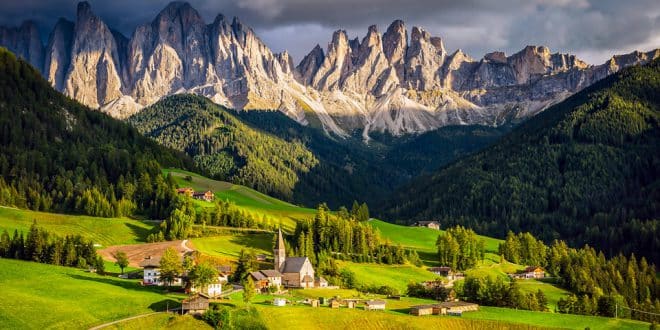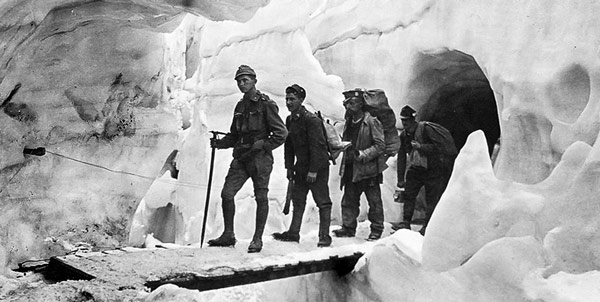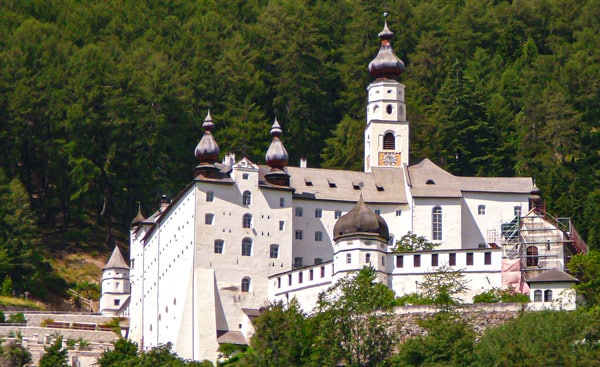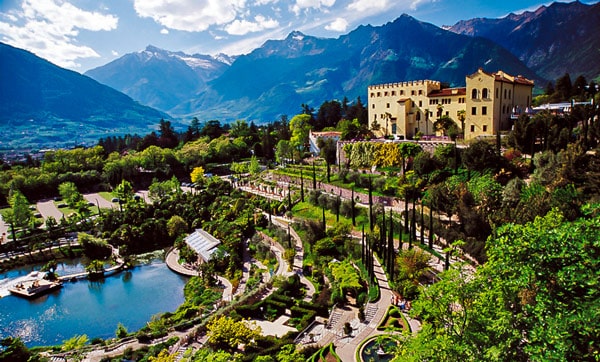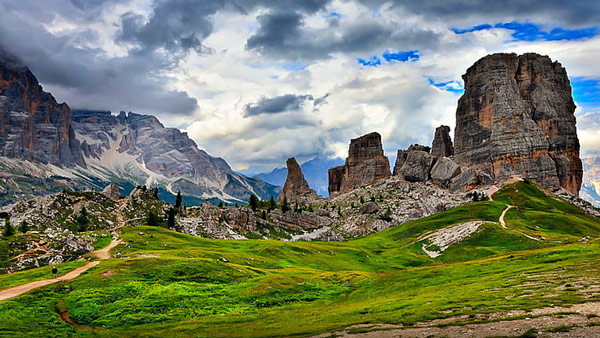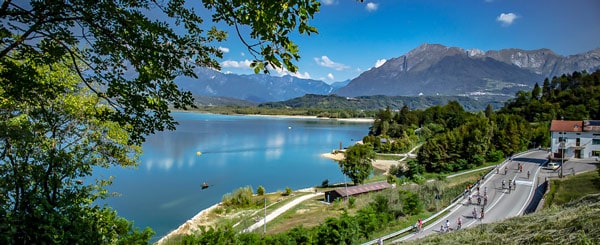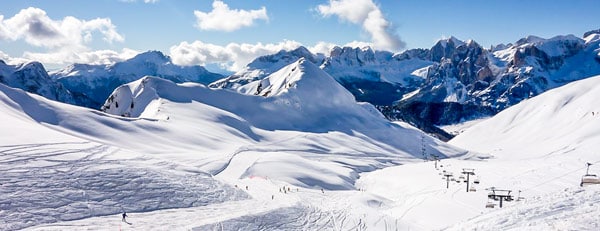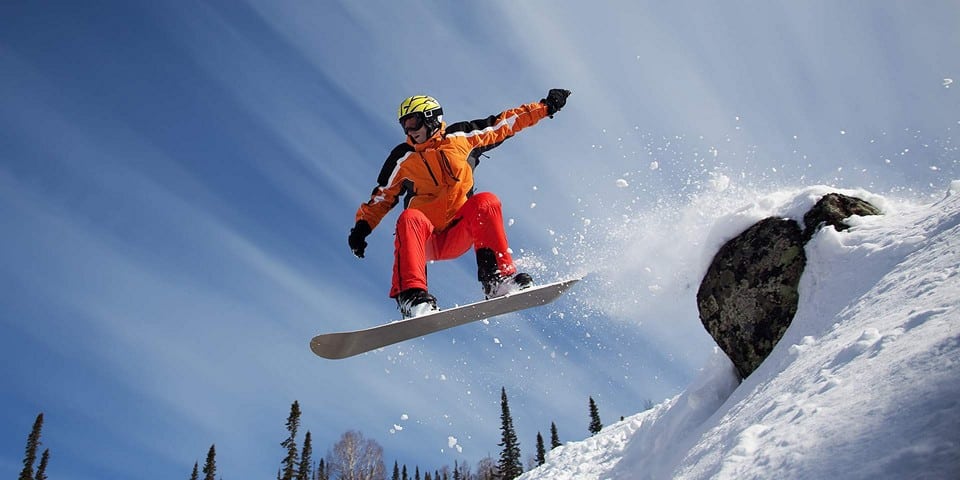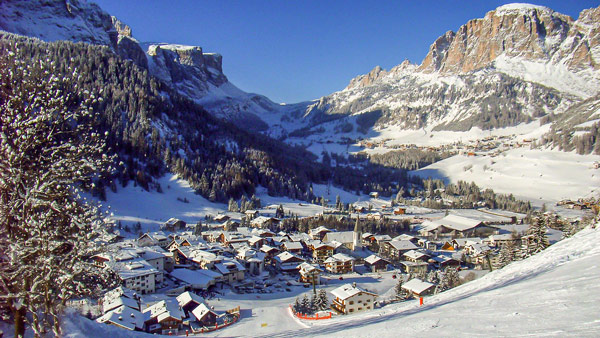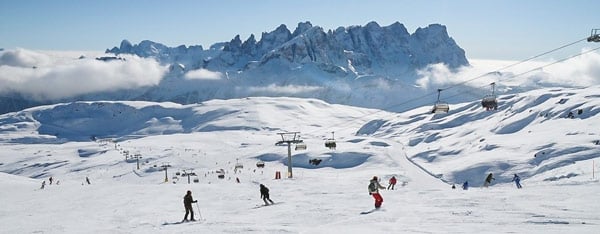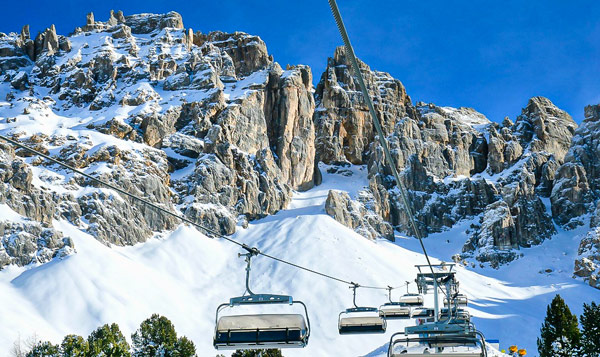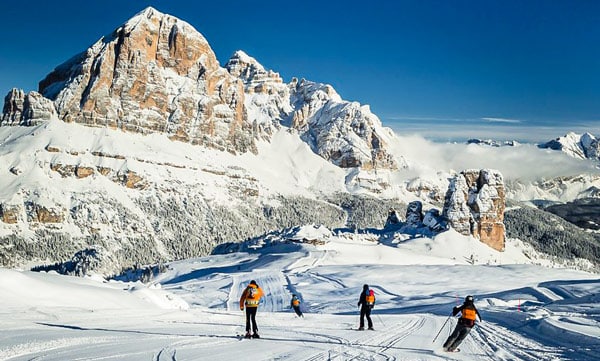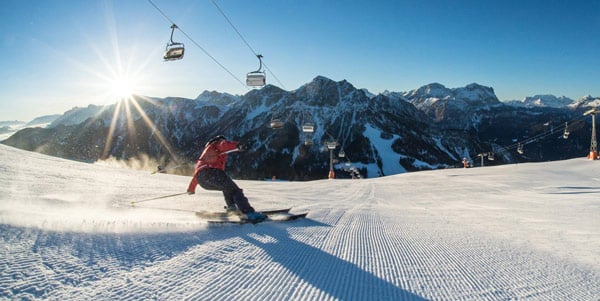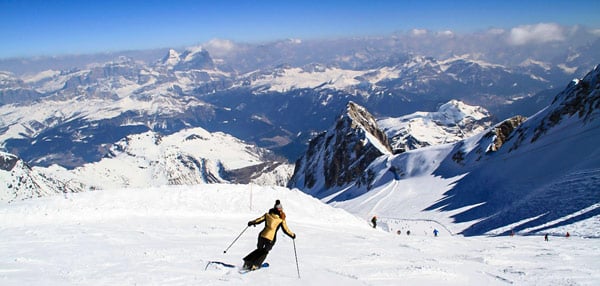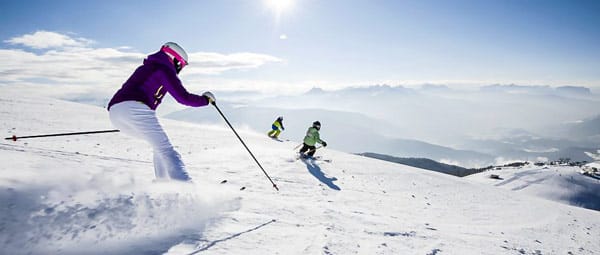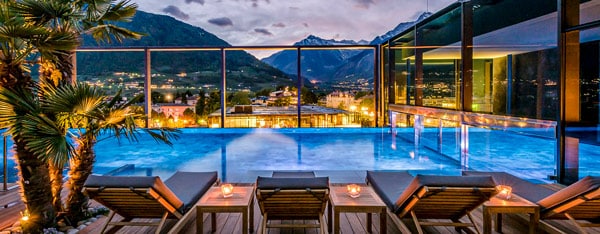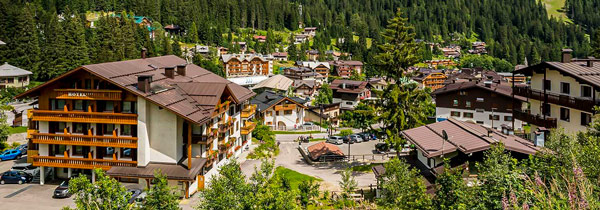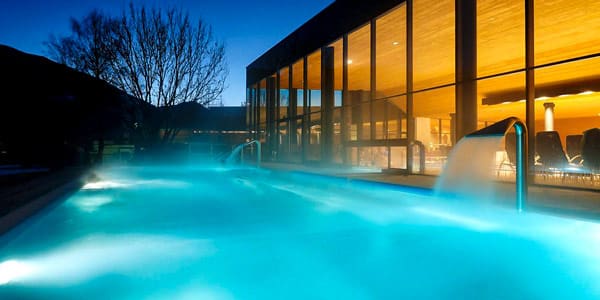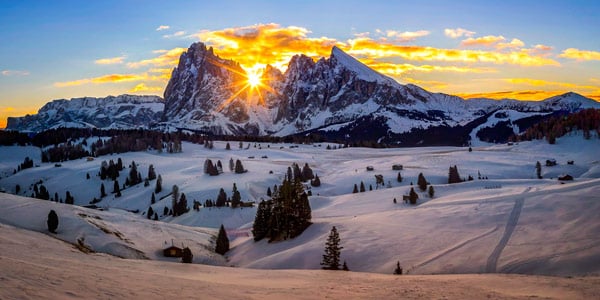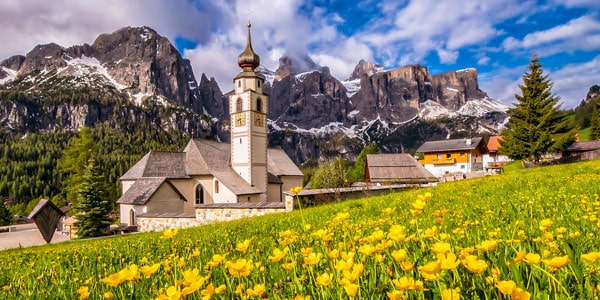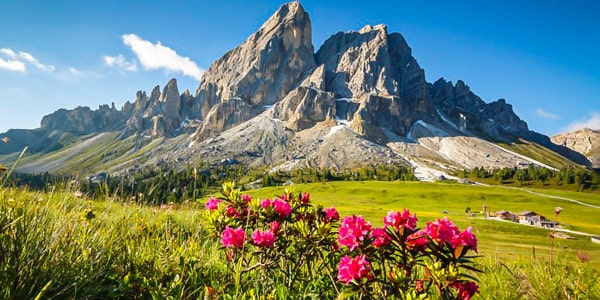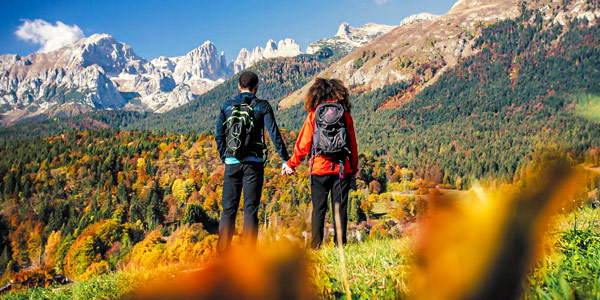The Dolomites, also known as the Dolomiti or the Dolomiti Alps, rank among Italy’s most popular tourist destinations. Travelers worldwide flock to this northeastern region to bask in its mesmerizing landscapes and crystal-clear air, experience the charm of ancient settlements, and enjoy excellent skiing at well-equipped resorts.
This breathtakingly beautiful place, aptly called “Italy’s White Crown,” has been recognized as a unique natural monument. Since 2009, it has been listed as a UNESCO World Heritage Site.
Page Contents
Geographic Data
The Dolomites encompass mountain ranges of the Eastern and Southern Limestone Alps, featuring 18 peaks around 9,843 feet (3,000 meters) in height. They stretch for about 93 miles (150 km). The highest peak, Marmolada or Marmolata (Marmolada), stands at 10,965 feet (3,342 meters) and is home to a large glacier. The entire area, nearly 6,178 square miles (16,000 km²), is divided among several provinces:
- Belluno (Provincia di Belluno);
- Bolzano (Provincia autonoma di Bolzano);
- Pordenone (Provincia di Pordenone);
- Trento (Provincia autonoma di Trento);
- Udine (Provincia di Udine).
Things to Know Before Visiting the Dolomites
What is the best time to visit the Dolomites?
Are the Dolomites worth visiting?
Where do you fly into to visit the Dolomites?
How many days were spent in the Dolomites?
What famous cities are closest to the Dolomites?
How far are the Dolomites from Venice?
What are the Dolomites famous for?
How do you visit the Dolomites without a car?
Historical Overview
The Dolomites have seen numerous shifts in governance, passing between different states over time. Before World War I, the mountain range was part of Austria-Hungary. From 1915 to 1917, the Dolomites became the backdrop for extensive military actions that claimed tens of thousands of lives. The Royal Italian Army, along with Anglo-French allies, clashed with Austro-German forces in areas like:
- Cristallo (Cristallo);
- Ampezzo (Ampezzo);
- Tofane (Tofane);
- Lagazuoi (Lagazuoi);
- Tre Cime di Lavaredo (Tre Cime di Lavaredo) and others.
Soldiers built thousands of kilometers of bypass tunnels and trenches, many of which, along with the remnants of bombs shattered on the cliffs, have been preserved to this day, marking a tragic imprint of the war.
In remembrance of the fallen, a network of routes was established through areas where battles took place and where Austrian and Italian military camps were located. The Dolomites also host a historical museum dedicated to World War I, featuring about 800 exhibits.
Located at 9,678 feet (2,950 meters), in the building of the cable car transfer station ascending Marmolada (Marmolada), the museum’s official website is www.museomarmoladagrandeguerra.com
Legends and Myths
During sunrises and sunsets, the cliffs bathe in bright orange, pink, and crimson red colors. This seemingly magical radiance is due to the carbonate of calcium and magnesium in the mineral composition of dolomite. The unusual color effect is enhanced by the mountains’ mysterious forms, resembling stone-carved Gothic towers.
The amazing natural phenomenon of the Dolomites, known as enrosadira, has stirred people’s imaginations for millennia, giving rise to numerous legends and myths.
Flora and Fauna
The flora and fauna of the Dolomites impress with their richness and diversity. The majority of the area is covered with picturesque meadows. In spring, over 50 species of orchids bloom here.
Coniferous and deciduous trees, including pine, cedar, fir, birch, alder, ash, maple, and oak, grow at various altitudes. The region is home to marmots, squirrels, martens, mountain goats, roe deer, deer, and mouflons. Brown bears, foxes, and wolves can also be encountered.
Bird species common in the area include partridges, owls, woodpeckers, eagles, golden eagles, capercaillies, and eagle owls.
In the crystal-clear waters of the mountain rivers and lakes, trout abound. Several reserves and park areas have been established in the Dolomites to preserve the region’s unique nature.
Historical and Natural Attractions
The Dolomites’ main attractions are their stunning mountain peaks, which the great 20th-century artist and designer Le Corbusier, a Frenchman of Swiss origin, once called “the most beautiful natural architecture in the world.”
Nonetheless, the region also boasts unique human-made structures several centuries old, offering immense historical and cultural interest.
Monte Maria Abbey
The Benedictine Monte Maria Abbey (Abbazia di Monte Maria), also known as Marienberg (Kloster Marienberg), is located near the village of Burgusio (Burgusio), in the commune of Malles Venosta (Malles Venosta).
Built on a mountainside at 4,377 feet (1,335 meters) above sea level, the monastery is the highest Christian structure in Europe. Founded in 1150, the abbey was constructed on the site of a small chapel dedicated to the Virgin Mary. It has experienced destruction, decline, plague epidemics, and devastating fires throughout its centuries but has always been reborn. In 1647, the monastery was rebuilt entirely, adopting Baroque features with some Romanesque elements.
In the abbey’s oldest part, the crypt (an underground vaulted space beneath the altar), unique frescoes influenced by the Byzantine school have been preserved.
Visitor access to this area is limited, but prior arrangement makes occasional guided tours available. In the courtyard of the temple complex, there is a museum housing valuable relics, ancient documents, and artworks that narrate the nearly 900-year history of the abbey.
- Official website of the abbey: www.marienberg.it
- Opening hours: Monday to Saturday from 9:00 AM to 11:30 AM and Monday to Friday from 2:00 PM to 4:00 PM
Tyrol Castle
The medieval Tyrol Castle (Castel Tirolo), resembling an impregnable fortress, is located in a small settlement of the same name near the city of Merano (Merano), in the province of Bolzano (Provincia Autonoma di Bolzano), part of the autonomous region of Trentino-Alto Adige (Trentino Alto Adige).
The Austrian border lies just over 62 miles (100 km) away, among the peaks of the Alpine mountains.
The construction of this fortification, done in Romanesque style, began in the first half of the 11th century and continued for centuries. The majestic and impregnable architectural complex, perched on a sheer cliff, underwent many changes and expansions over the years, including the addition of a tower, dining hall, palace, and chapel. The castle once served as the residence of the rulers of Tyrol (Tirolo). Extensive restoration work on this ancient architectural and historical monument occurred in the 19th and 20th centuries. Today, Tyrol Castle houses a museum with interesting exhibits that tell the region’s story.
- Castle and museum website: www.schlosstirol.it
- Ticket price: 7 euros, free for children under 6
Botanical Garden and Trauttmansdorff Castle
Trauttmansdorff Castle (Castel Trauttmansdorff), built in 1850 on the ruins of a medieval fortress from the 14th century, along with the enchanting gardens surrounding it, are considered among the most popular attractions in South Tyrol, also known as Alto Adige (Alto Adige).
The estate, constructed in the Neo-Gothic style, belonged to the Austrian noble Trauttmansdorff family. Empress Elisabeth of Bavaria, wife of Franz Joseph I and known as Sisi, loved to visit here with her daughters, especially in the winter, to enjoy the magical atmosphere of the Southern Alps.
During World War II, the castle was used as a German army base, and several years later, most of its architectural structures were on the brink of destruction.
In the late 1970s, the former noble estate was acquired by the government of the autonomous province of Bolzano. In 1988, local authorities created a botanical garden adjacent to Trauttmansdorff Castle. About 100,000 plant species thrive on 30 acres (12 hectares), including rare specimens worldwide, thanks to ideal climatic conditions. The luxurious Trauttmansdorff gardens and greenhouses, featuring 80 thematic sections, were recognized in 2005 as Italy’s most beautiful landscape art object.
The castle itself has undergone reconstruction over time. Between 2000 and 2003, the facade, chapel, and crypt were renovated. The interior living quarters, including Empress Elisabeth’s apartments, were restored. An unusual museum inside the castle presents exhibits on the region’s history and local tourism development.
- Official website of the castle: www.trauttmansdorff.it – check for current schedules, but usually, it’s open from 9:00 AM to 5:00 PM, and until 11:00 PM in the summer months.
- Adult ticket price is 14 euros, free for children under 6.
Tre Cime di Lavaredo Mountains
The Tre Cime di Lavaredo (Tre Cime di Lavaredo) mountains are recognized as one of the most iconic symbols of the Dolomites.
They are located on the border of the Belluno and Bolzano provinces. The three main peaks of the massif, incredibly popular among climbers, are named:
- Cima Grande (Cima Grande);
- Cima Ovest (Cima Ovest);
- Cima Piccola (Cima Piccola).
Due to easy transportation access, the Tre Cime di Lavaredo mountains are considered the most attractive destination for mass tourism.
Several trails of varying difficulty lead to the summits, with rest areas equipped for visitors. The site attracts climbers, skiing enthusiasts, photographers, and artists. The first to conquer the sharp spires and jagged ridges of Cima Grande (9,839 feet (2,999 meters) above sea level) was the Austrian writer Paul Grohmann, who left detailed sketches of the area and numerous publications about the Dolomites. The ascent took place in August 1869. The northern face of Cima Grande was conquered only in the early 20th century, more than 60 years later. The first to reach the other two peaks was the climber Michael Innerkofler, who made the ascent in 1879 and 1881.
—
Cinque Torri Mountains
The name of the small mountain range, Cinque Torri (Cinque Torri), translates from Italian as “five towers.”
Part of the Eastern Dolomites, this massif is located northwest of the commune of San Vito di Cadore (San Vito di Cadore) and southwest of the resort town of Cortina d’Ampezzo (Cortina d’Ampezzo).
The highest point is the peak of Torre Grande, 7,746 feet (2,361 meters) above sea level. The “five towers” ascent is very popular among beginner climbers. The trip is also a delight for eco-tourism enthusiasts. Visitors are offered comfortable accommodation in cozy mountain refuges known as Rifugio.
Santa Croce Lake
The natural Santa Croce Lake (Lago di Santa Croce) is located on the border of the Belluno province, in the Veneto region (Veneto), at an altitude of 1,312 feet (400 meters) above sea level.
The mirror-like water surface reflects the peaks of the majestic Alpago (Alpago) and Nevegal (Nevegal) mountains. In late autumn and spring, fishing enthusiasts visit the lake home to trout, perch, pike, carp, and chub. During the summer, three beautiful beaches are equipped for visitors, along with picnic areas. Comfortable hotels, holiday camps, and campgrounds are built along the shore. Horse riding in the forest coolness and freshness of the alpine meadows is a popular activity in the valley. The lake is also top-rated among cyclists.
For extreme sports fans, paragliding flights are offered, launching from the summit of Mount Alpago.
Misurina Lake
Misurina (Lago di Misurina), a natural glacial lake, is located at the foot of the Tre Cime di Lavaredo mountain, at an altitude of 5,741 feet (1,754 meters) above sea level, in the commune of Auronzo di Cadore (Auronzo di Cadore), in the Belluno province of the Veneto region.
The lake’s perimeter is 1.6 miles (2.6 kilometers), and its maximum depth is no more than 16 feet (5 meters). In winter, the lake freezes over. In 1956, speed skating competitions were held on the lake’s natural ice during the VII Winter Olympics.
Misurina is rightly called the “pearl of Cadore.” The water in the lake is crystal clear, but the rocky shore does not allow swimming. A favorite pastime for tourists in the warmer months is boating and catamaran rides. The infrastructure is well-developed, with about 10 hotels built around the lake, accommodating nearly 500 visitors.
Thanks to its unique microclimate and pure mountain air, the area near the lake has become a popular destination for rest and treatment for people suffering from respiratory diseases.
Lago di Braies (Pragser Wildsee)
Lago di Braies (Pragser Wildsee), often described with such vivid adjectives as mysterious, enticing, and enchanting, is a stunning natural attraction located in South Tyrol, about 1.5 hours’ drive from the town of Bolzano (Bolzano), at an altitude of 4,898 feet (1,496 meters) above sea level.
Every year, thousands of tourists worldwide come here to admire the mesmerizing view of the emerald water surface. The lake, with depths reaching up to 118 feet (36 meters) in places, is situated at the foot of the Croda del Becco (Croda del Becco) cliff. This natural monument is part of the Fanes-Sennes-Braies (Parco naturale Fanes-Sennes-Braies) national park and nature reserve.
Local residents pass down a legend from generation to generation about how, in ancient times, mysterious guardians of gold dwelling in the mountains exchanged precious metal for food with local shepherds. They excavated underground sources to protect their treasures from plunder, causing water to flood the valley. Thus, the emerald Lago di Braies was formed at the foot of the impregnable mountains. One of the most popular activities here is boating. Visitors can also enjoy leisurely walks around this picturesque spot; the total length of the tourist route around the lake is about 2.2 miles (3.6 kilometers).
Could be useful for you: a review of the best 5-star hotels in the Dolomites.
Ski Resorts
The Dolomites are considered a paradise for winter sports enthusiasts. About 500 modern and convenient ski lifts serve over 932 miles (1,500 kilometers) of slopes, suitable for beginners and professionals.
The region encompasses 12 major valleys with resort towns and villages, each boasting a well-developed infrastructure for a comfortable stay. There are numerous cafes, restaurants, and bars with breathtaking views near the ski areas.
There are about 50 ski resorts in the Dolomites – distances between them are short, and excellent transportation links allow tourists to easily visit nearby villages. Many resort communities are famous for their rich history and unique traditions. The region hosts important global-level winter sports competitions.
Val di Fassa
The picturesque resort of Val di Fassa (Val di Fassa) is located in the northeastern part of the autonomous province of Trentino.
The eponymous valley stretches at the foot of the Marmolada and Catinaccio (Catinaccio) mountains, as well as the Sella (Gruppo del Sella) and Sassolungo (Gruppo del Sassolungo) massifs. The main source of income for local communities is the hotel business, catering to skiing enthusiasts. The settlements include:
- Moena (Moena);
- Soraga di Fassa (Soraga di Fassa);
- Vigo di Fassa (Vigo di Fassa);
- Pozza di Fassa (Pozza di Fassa);
- Mazzin (Mazzin);
- Campitello di Fassa (Campitello di Fassa);
- Canazei (Canazei).
In the early 1970s, these tourist bases were united into a network of resorts called “Dolomiti Superski” (Dolomiti Superski).
The most popular route, comprising both challenging and easy slopes, is the Sella Ronda (Sella Ronda). The length of this circular track, which encircles the eponymous mountain range, is about 311 miles (500 kilometers). In the nearby vicinity, there are numerous establishments where visitors can relax and enjoy local cuisine. The resort offers several dozen schools for beginner athletes, with training conducted by certified instructors. At the same time, the Sella Ronda route, often called the “carousel” or “round the world,” is possible in both directions.
Val Gardena
The slopes and lifts near the famous Val Gardena valley are also part of the “Dolomiti Superski” association.
In this resort area, various communities are situated at different levels on the slopes, each equipped for maximum comfort. There are modern hotels with pools and spa complexes, restaurants offering Alpine cuisine, and shops. The settlements include:
- Ortisei;
- Santa Cristina Valgardena;
- Selva di Val Gardena.
These resort communities in the valley are connected by a unified system of slopes and lifts. The territories adjacent to the mountain range are part of the Sella Ronda route, which stretches for about 108 miles (175 kilometers). These lands, once belonging to the Austrians, became part of Italy in the early 20th century. The region is considered an attractive vacation spot for tourists with children and those just starting to ski or snowboard.
Additionally, Val Gardena annually hosts significant international competitions, such as the men’s downhill World Cup stage.
Alta Badia
Tourists wishing to relax in Alta Badia should head to South Tyrol, in the province of Bolzano.
Several resort communities here are interconnected by cable car. These include:
- La Villa;
- San Cassiano;
- Corvara;
- Pedraces;
- La Val;
- Colfosco.
Most of these villages are part of the Sella Ronda “carousel” route. The network of lifts makes it easy to access other skiing areas (Val Gardena, Val di Fassa, and Arabba-Marmolada) from the upper part of Val Badia.
Local ski slopes cover approximately 81 miles (130 kilometers), with most routes suitable for beginners or intermediate-level skiers. The region is also part of the “Dolomiti Superski” system. The resort is very popular among beginners and those looking to enjoy the mountains with children.
Tre Valli
The Tre Valli resort, located on the border of the Trento and Belluno provinces, translates from Italian as “three valleys.”
The ski slopes and lifts are spread among the following communities:
- Moena;
- Passo San Pellegrino;
- Falcade.
There are ample opportunities for active winter recreation: tourists can enjoy snowboarding, skating, skiing, and snowmobiling. In Falcade, several sports centers and schools operate, along with swimming pools and spa complexes.
Those who enjoy evening entertainment will find plenty to do in Moena, with its nightclubs, clubs, and discos. The Passo San Pellegrino area offers a more tranquil atmosphere.
Val di Fiemme
The resort in Val di Fiemme, located in the northeastern part of the autonomous region of Trentino-Alto Adige, has long gained worldwide recognition. The International Ski Federation has held major sports championships here three times.
The resort area, known as the “Gateway to the Dolomites” due to its convenient location, includes 11 settlements, with a total local population of no more than 20,000 people. The ski slopes are over 87 miles (140 kilometers), with approximately the same length for cross-country skiing routes. The largest communities, Cavalese and Predazzo are medieval settlements distinguished by their unique culture and rich history.
Cortina d’Ampezzo
The resort town of Cortina d’Ampezzo is referred to as the “mountain pearl” and “queen” of the Dolomites.
Located in the northern part of the Belluno province, it is 27 miles (44 kilometers) from the Austrian border. During the tourist season, the local population, about 6,000 people, increases by 5 to 6 times. The resort is famous not only for its magnificent ski slopes, which extend for about 75 miles (120 kilometers) but also for its excellent tourist infrastructure, ensuring a truly luxurious stay.
Kronplatz
Located in the province of Bolzano, the Kronplatz ski resort (Kronplatz, Italian: Plan de Corones) is part of the “Dolomiti Superski” sports and tourist alliance.
The area covers 14 communities at elevations ranging from 2,579 to 5,413 feet (786 to 1,650 meters) above sea level. The settlements, with their developed and modern infrastructure, are centered around the eponymous skiing area and are an ideal place for winter sports enthusiasts. Bus service connects all the communities, with the main station in the largest town, Brunico (Brunico). The total length of ski and snowboard slopes and lifts is 74 miles (119 kilometers), with 32 lifts. The natural attraction of the Kronplatz resort area is the picturesque Pustertal (Pustertal) valley, enchanting with its fairy-tale views.
Arabba-Marmolada
The small Arabba-Marmolada resort, located in the province of Belluno at an altitude of 5,249 feet (1,600 meters) near the Val Livinallongo , captivates the hearts of those who consider themselves professionals in winter sports.
For beginners and children, less extreme Dolomite routes might be more suitable. The skiing area, circling the Marmolada massif from the north, includes slopes stretching for 37 miles (60 kilometers). These slopes are known for their breathtaking speed descents, requiring great skill and focus from athletes.
The elevation changes reach about 5,479 feet (1,670 meters). The Arabba-Marmolada territory is part of the Sella Ronda circular route. It is connected by cable car to nearby areas.
From here, it’s easy to reach other resort zones such as Alta Badia, Val Gardena, and Val di Fassa. Popular activities include climbing, snowshoeing, and tobogganing.
Valle Isarco
The Valle Isarco ski resort (Valle Isarco), which includes 17 communities interconnected by cable car, became part of the unified “Dolomiti Superski” skiing area in 1979.
The tourist boom here started at the beginning of the last century. The first lift opened in 1910 in Plose , located at an altitude of 8,202 feet (2,500 meters) near the ancient town of Bressanone. One of the most popular slopes of the Valle Isarco resort is Trametsch, stretching for 5.6 miles (9 kilometers), and it is the longest downhill ski run in South Tyrol. The main routes for skiers and snowboarders are Plose, Gitschberg-Maranza and Jochtal . Specially equipped viewing terraces with panoramic views of the mountains are particularly noteworthy.
Thermal Springs
In the Dolomites, there are about 10 thermal resorts. It’s known that even in ancient times, Roman legionnaires came here for treatment in the healing springs.
Merano
The thermal baths in Merano have gained significant popularity among modern tourists.
Bathing in the springs with radon mineral water helps treat musculoskeletal disorders, endocrine-metabolic disorders, and nervous system diseases and also restores digestive organ functions.
Val Rendena
Several thermal resorts are near Val Rendena in South Tyrol.
Local spa centers specialize in treating skin diseases, joint problems, and respiratory system ailments.
Valsugana
In the Valsugana Valley (Valsugana), there are unique springs in Italy with arsenic-iron water, calming the nervous and cardiovascular systems.
People come here to restore the musculoskeletal system and treat respiratory pathologies.
Brennero
There is also a thermal treatment and wellness center in the commune of Brennero, located in the northern part of the Trentino-Alto Adige region at an altitude of about 3,280 feet (1,000 meters) above sea level.
The local spring’s mineral water is enriched with calcium, magnesium, and other beneficial elements. It is recommended for dermatological diseases, kidney pathology, chronic sinusitis, and bronchitis.
How to Get There
Flying is the fastest and most convenient way to reach the Dolomites. The nearest airports to the region are in the cities of:
- Treviso;
- Venice;
- Verona;
- Malpensa, Milan;
- Bergamo.
Travelers head to the province of Bolzano, which is almost at the center of the most popular mountain resorts in the Dolomites, and from there they can reach their destination by bus or rented car (see Road Trips Section). From Treviso, Venice, and Padua (Padova), you can take trains from ItaloTreno or Trenitalia to Belluno. The provinces of Trento and Bolzano are also connected by rail to the cities of Verona, Bologna, and Brescia.
Seasonality and Weather: Best Time to Visit the Dolomites
The Dolomites are ranked among the most amazing places in the world, captivating travelers with their unforgettable attractions regardless of the season. However, most tourists prefer to visit during the skiing and snowboarding season, which lasts from late November to early April.
Winter
During winter, the average temperature ranges from 32°F to 23°F (0°C to -5 °C).
The coldest months are February and January, sometimes dropping to -4°F (-20°C). However, the humidity in the Dolomites is low, making the cold more bearable, and about 8 out of 10 days are clear and sunny.
Check out tips for winter holidays in Italy
Spring
In spring, temperatures vary between 50°F and 68°F (+10°C to +20°C). It’s cooler in the mountains.
In April, snow still covers the slopes. May begins the blooming period, filling the air with divine scents. Spring is a wonderful time for hiking and connecting with nature.
Summer
The summer season in the Dolomites lasts from the second half of June, when the last snow melts in the mountains, to mid-September, when the first cold weather sets in.
Most refugios (Alpine tourist shelters) are open during this time, and lift stations and regular bus services operate between communities. Summers are never too hot in the region. August is considered the rainiest month. June and July are ideal for trekking and mountain biking.
Autumn
In September, the tourist influx significantly decreased. However, the weather remains warm at the end of the month, with temperatures around 59°F (+15°C) and higher.
Autumn in the Dolomites attracts photographers, artists, and those seeking a secluded vacation. In October, fogs become very frequent, adding a touch of mystery to the landscapes. By late autumn, the ski season begins.
Dolomites Ski Resorts & Sights on Google Map
The map below includes all the ski resorts, attractions, and interesting places mentioned in this guide. I recommend studying the geographical location of these destinations before planning your trip to the Alps.
If you have any questions, I’d gladly advise you on your trip to the Dolomites in the comments.
 Italy for me From Italy with love
Italy for me From Italy with love

